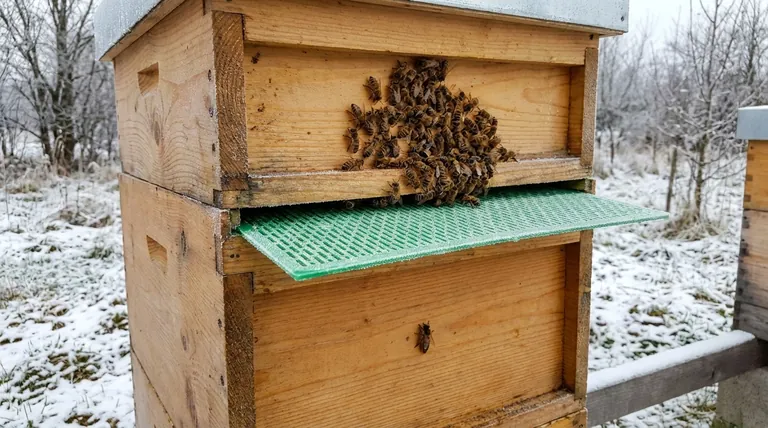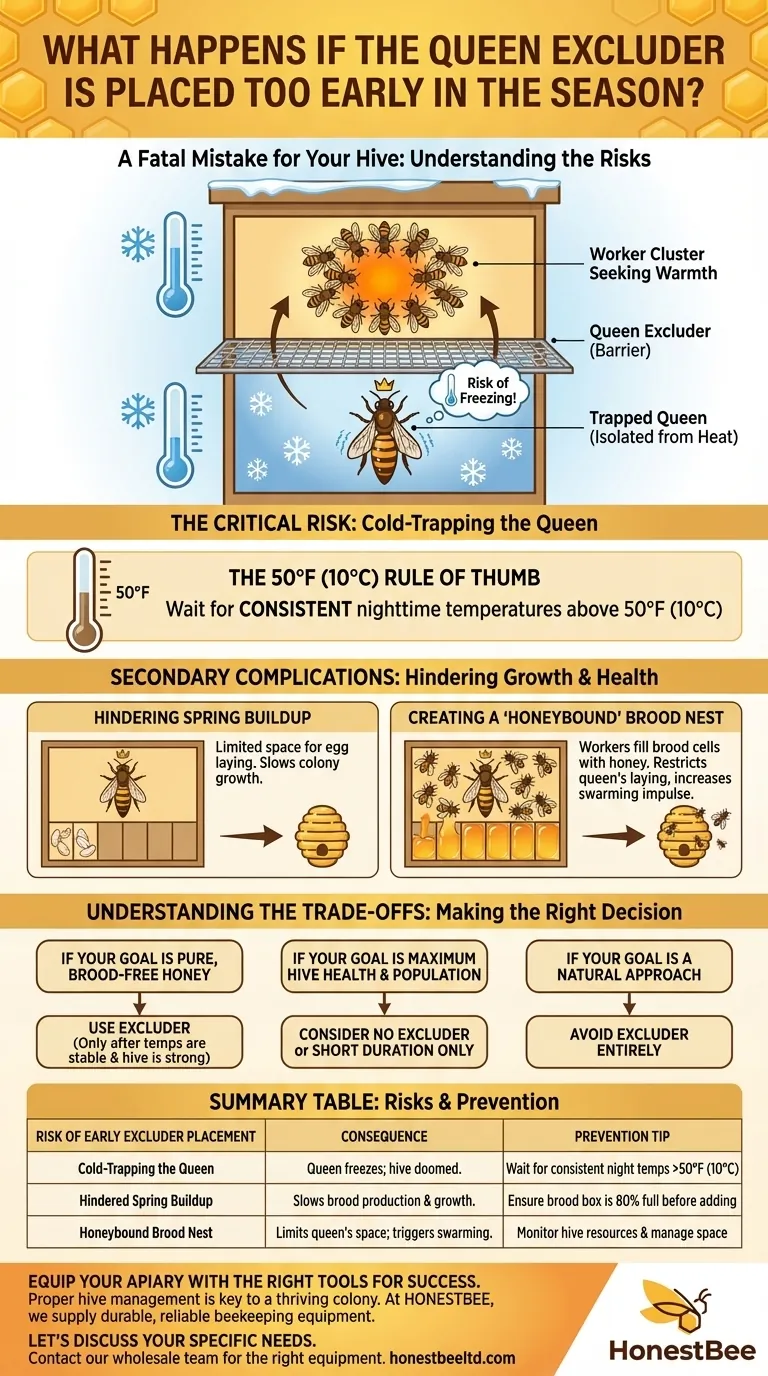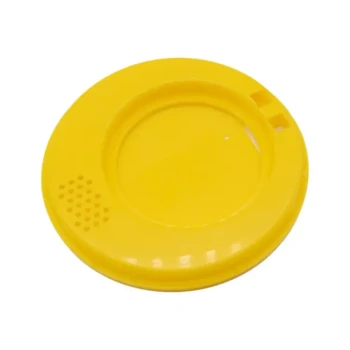Placing a queen excluder too early in the season can be a fatal mistake for your hive. During an unexpected cold snap, the worker bee cluster may migrate into the upper portions of the hive for warmth, leaving the queen trapped below the excluder. Isolated from the cluster's heat, she can easily freeze to death, dooming the colony.
The core issue is not just a date on the calendar, but a fundamental conflict with the hive's natural thermoregulation. An improperly timed excluder acts as a lethal barrier, preventing the queen from staying with the life-sustaining warmth of her colony during critical temperature drops.

The Critical Risk: Cold-Trapping the Queen
How the Bee Cluster Manages Temperature
A honey bee colony survives the cold by forming a tight cluster. The bees generate heat by vibrating their flight muscles, keeping the center of the cluster—and the queen—at a survivable temperature.
This cluster is not static; it will slowly move throughout the hive to access honey stores and maintain optimal warmth.
The Excluder as a Lethal Barrier
If the cluster decides to move upward into a top box for warmth or food, the worker bees can easily pass through the excluder. The queen, however, is too large and gets left behind.
Even a single cold night can be enough to kill a queen who is separated from her colony's warmth. This is the single most catastrophic outcome of placing an excluder too early.
The 50°F (10°C) Rule of Thumb
The most critical safeguard is to wait until nighttime temperatures are consistently above 50°F (10°C) before adding the excluder. This ensures that even if the queen were to become temporarily separated, the ambient temperature would not be lethal.
Beyond Timing: Secondary Complications
Hindering Spring Buildup
Early spring is a period of explosive population growth. The queen needs ample space to lay thousands of eggs per day.
Placing an excluder too early can confine her to a single box that she may quickly fill. This lack of space can slow brood production and weaken the colony's potential just before the main honey flow.
Creating a "Honeybound" Brood Nest
If a strong nectar flow begins while the queen is confined to the brood box, the workers may begin to store nectar in empty cells the queen would have used for eggs.
This condition, known as being honeybound, severely restricts the queen's laying capacity and can significantly increase the hive's impulse to swarm. It requires active intervention from the beekeeper to correct.
Understanding the Trade-offs
The Benefit: Clean Honey Supers
The sole purpose of a queen excluder is to prevent the queen from laying eggs in the honey supers. This results in clean, brood-free frames, which simplifies the honey extraction process for the beekeeper.
The Cost: Increased Management and Risk
Using an excluder is not a "set it and forget it" solution. It creates an unnatural barrier that requires careful management.
It forces the beekeeper to monitor for honeybound conditions, adds stress to worker bees whose wings can be damaged by repeatedly passing through the grid, and traps drones, which then die and can clog the excluder.
The Alternative: No Excluder
Many successful beekeepers do not use excluders at all. They rely on the hive's natural tendency to keep the brood nest consolidated, with the queen moving downward as workers backfill upper frames with honey. This approach requires less intervention but may result in some brood being present in honey frames.
Making the Right Decision for Your Hive
The decision to use an excluder depends entirely on your beekeeping goals and management philosophy.
- If your primary focus is pure, brood-free honey: Use an excluder, but only after nighttime temperatures are stable and the brood box is at least 80% full of bees, brood, and resources.
- If your primary focus is maximum hive health and population: Consider forgoing the excluder or adding it only for the short duration of the peak honey flow to avoid limiting the queen.
- If your primary focus is a more "natural" approach to beekeeping: Avoid the excluder entirely and learn to manage your hive based on its natural cycles of expansion and contraction.
A queen excluder is a tool that trades natural hive function for beekeeper convenience, and it must be used with a deep understanding of its consequences.
Summary Table:
| Risk of Early Excluder Placement | Consequence | Prevention Tip |
|---|---|---|
| Cold-Trapping the Queen | Queen is isolated from the heat cluster and freezes. | Wait for consistent nighttime temps above 50°F (10°C). |
| Hindered Spring Buildup | Queen is confined, slowing brood production and colony growth. | Ensure the brood box is at least 80% full before adding. |
| Honeybound Brood Nest | Workers store honey in brood cells, limiting queen's space and triggering swarming. | Monitor hive resources and manage space actively. |
Equip your apiary with the right tools for success.
Proper hive management is key to a thriving colony. At HONESTBEE, we supply commercial apiaries and beekeeping equipment distributors with the durable, reliable supplies needed to support healthy hives and maximize honey production.
Let's discuss your specific needs. Contact our wholesale team today to get the right equipment for your operation.
Visual Guide

Related Products
- High Performance Plastic Queen Excluder for Beekeeping and Apiary Management
- Professional Plastic Queen Excluder for Modern Beekeeping
- Wooden Queen Bee Excluder for Beekeeping
- HONESTBEE 6 Frame Three Use Electric Honey Extractor for Beekeeping
- Metal Queen Bee Excluder for Beekeeping
People Also Ask
- What are the benefits of a queen excluder? Ensure Pure Honey & Simplify Hive Management
- When is the best time to place a queen excluder? Optimize Honey Production & Purity
- What happens if I don't use a queen excluder? Understand the impact on your honey harvest.
- What impact does a queen excluder have on colony defensiveness? Control Hive Temperament for Safer Beekeeping
- When is the typical time frame for harvesting honey and removing the queen excluder? Optimize Your Hive Management



















